WooCommerce Checkout Add-Ons lets you add fields to the checkout page, which can be used to gather information from your customers, upsell services and products, and much more. Customers can view and modify these fields during checkout to add tips, gift wrapping, rush handling, gift messages, and more to their purchases.
Checkout Add-Ons are not dependent on the products in an order, but are added to the entire order. If you're looking for add-ons that only apply to certain products, please check out the Product Add-ons extension.
This plugin cannot manage inventory or SKUs for add-on "products" or services, as they essentially act like fees.
Translation ready! Text Domain: woocommerce-checkout-add-ons
As of WooCommerce 8.3, Cart and Checkout blocks are available as the default experience. WooCommerce Checkout Add-ons has not yet been updated to be compatible with those blocks, so we recommend following this guide to revert to Cart/Checkout shortcodes.
Additional plugin updates will soon be released to ensure compatibility with the new block checkout. Please check out this page for the latest updates or reach out to our support team with any questions!
Installation
↑ Back to top- Download the extension from your WooCommerce dashboard.
- Go to Plugins > Add New > Upload and select the ZIP file you just downloaded.
- Click Install Now and then Activate.
- Go to WooCommerce > Checkout Add-ons and read the next section to learn how to use the plugin.
Setup and Configuration
↑ Back to topYou can decide where your add-on fields will appear on the checkout page – before or after the billing details section or before the order summary (default) – by adjusting the display setting:
- Go to Appearance > Customize.
- Select WooCommerce > Checkout.
- Select the desired display setting from the Checkout Add-Ons display menu.
- Click Publish.

Determine the position of the add-ons on the checkout page
On the same Customize tab, you can choose if you want to apply percentage adjustments based on the total or subtotal of the order.
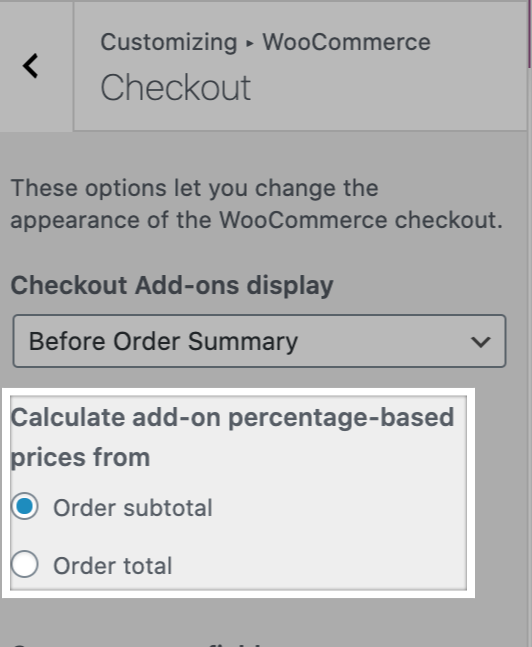
Creating Checkout Add-ons
↑ Back to topTo create a checkout add-on, go to WooCommerce > Checkout Add-Ons and click Add add-on.
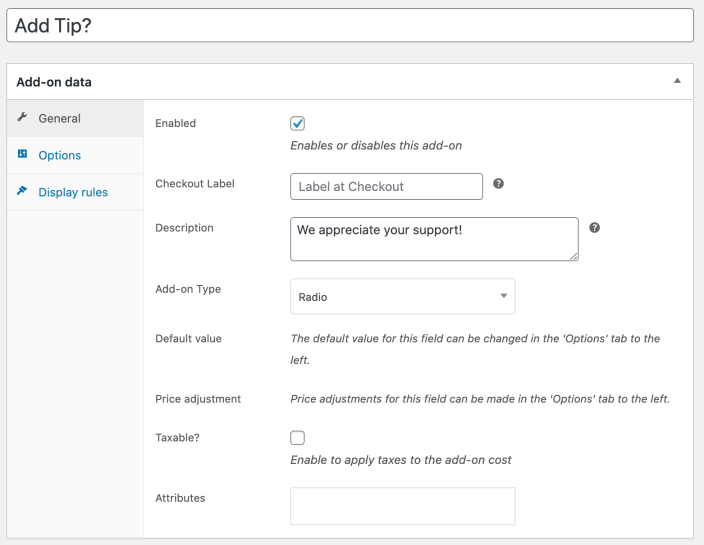
You can now begin creating your checkout field! On the General tab, you can modify the following fields:
- Enabled: Add-ons are enabled by default, but can be disabled if you want to temporarily remove them without completely deleting them from your site.
- Checkout Label: Optional. Customer-facing label for this add-on. If left blank, the add-on Title will be used.
- Description: Optional. Customer-facing field where you can provide additional context about the add-on. Supports limited HTML.
- Add-on Type: Choose the add-on field type.
- Default value: Optional. The value that should be prepopulated for the field on the checkout page.
- Price adjustment: Optional. Determine the fee or discount associated with this add-on, as either a fixed amount or a percentage.
- Taxable?: Determines if tax rates should apply to the add-on. This setting will only appear if taxes are enabled for your store.
- Tax Rate: If taxable, determines which tax rate will apply to the add-on.
- Attributes: Optional. These settings impact whether the add-on field is required and if/how it should be displayed on the Orders page.
Add-on Types
↑ Back to top| Type | Description | Example Use Case |
|---|---|---|
| Text | Customer can enter a short string of text. | Gift recipient’s name |
| Text Area | Customer can enter a long string of text. | Gift messages |
| Select | Customer can select one option from a drop-down menu. | Gift wrapping options |
| Multiselect | Customer can select one, several, or all options from a drop-down menu. | Shipping and handling add-ons (e.g. Add Insurance, Add Rush Handling, etc.) |
| Radio | Customer can select one option from a list of radio buttons. | Choosing whether or not the order contains a gift. |
| Checkbox | Customers can select a single checkbox. | Adding a fixed-amount donation |
| Multi-checkbox | Customer can select one, several, or all options from a list of checkboxes. | Gift wrapping add-ons (e.g. Add a bow, Add tissue paper, etc.) |
| File | Customer can upload a file to include in their order, which you can access from your Media Library or when viewing the order. | Custom card cover |
Here’s an example of how each field appears on the checkout page:
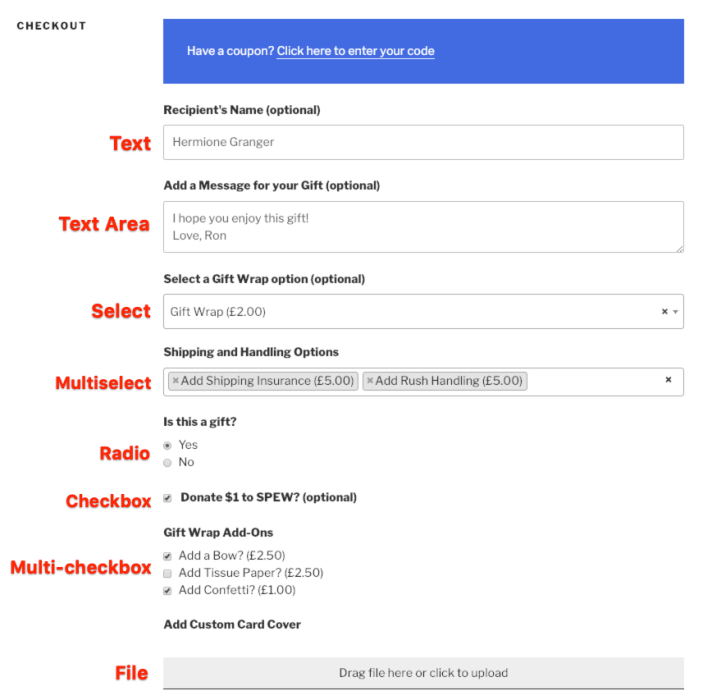
Options
↑ Back to topYou can set default values for all add-on types except “File”.
For the “Text” and “Text Area” add-on types, you can define the default on the General tab:
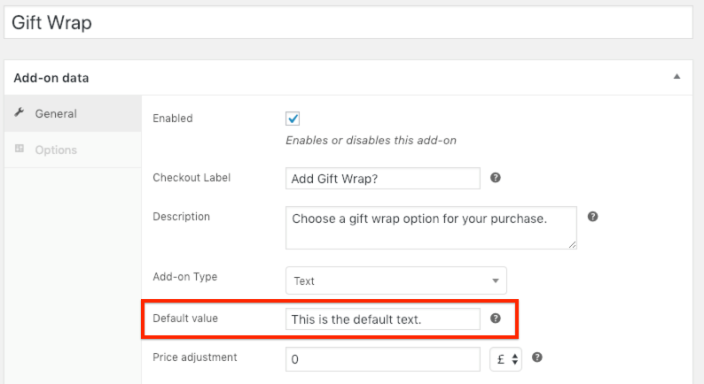
For all other eligible add-on types, you must navigate to the Options tab to set the default. For the “Multiselect” and “Multi-checkbox” add-on types, which let customers select more than one option, you can also set multiple defaults:
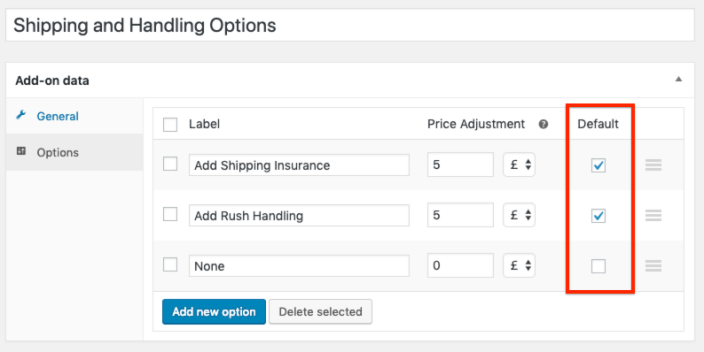
Price Adjustments
↑ Back to topYou can choose to associate fees or discounts in either fixed amounts or percentages for all add-on types.
To add a fee, enter the price adjustment as a positive value, such as 2.50. To add a discount, enter the price adjustment as a negative value, such as -2.50.
When setting the price adjustment as a percentage, the adjustment will be calculated based on the order’s subtotal.
For the “Text”, “Text Area”, and “File” add-on types, you can set the price adjustment on the General tab:
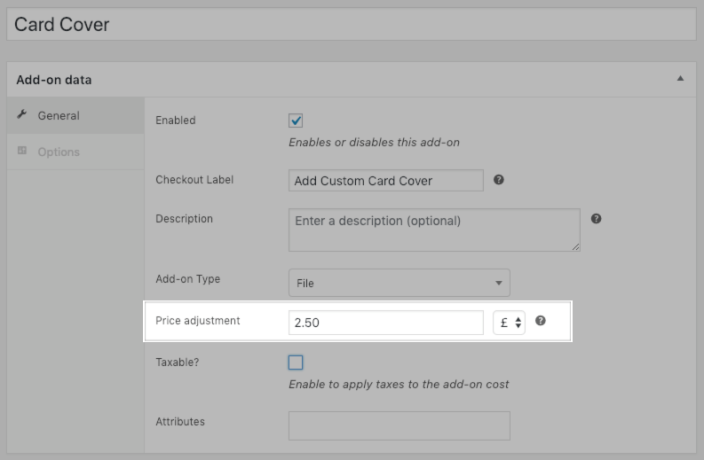
For all other add-on types, price adjustments can be set on the Options tab:
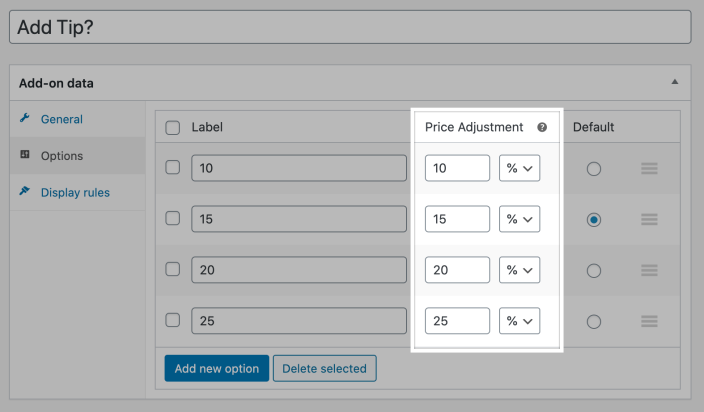
Display rules
↑ Back to topYou can customize add-ons so they’ll only appear when certain conditions are met:
- Cart subtotal: add-on will only appear when the cart subtotal is within the indicated range
- Product or category in cart: add-on will only appear when any of the listed products or product categories are in the cart.
- Add-on value: this add-on will appear based on the value of another add-on. This is great for gift options – if someone has indicated that the purchase is a gift, you can then offer options like gift wrapping or a custom card.
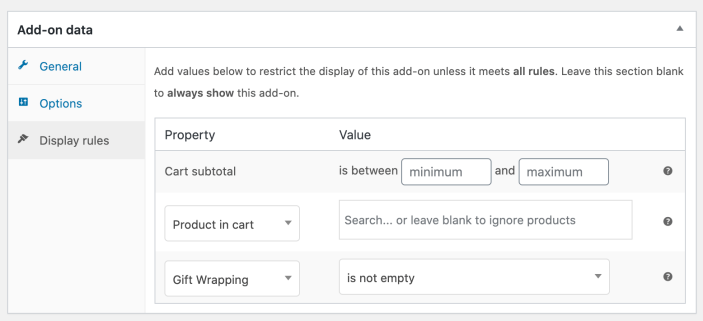
Attributes
↑ Back to topThere are five attributes you can set for checkout add-ons:
- Required: If selected, the customer cannot place the order until the field is populated or selected. Adds a red asterisk to the field to denote its requirement.
- Display in View Orders screen: Adds the add-on field to the Orders list so you can view its values across orders in one screen.
- Allow Sorting on View Orders screen: Lets you sort the Orders list alphabetically/numerically by the add-on field’s value. Cannot be set for “Multiselect”, “Multi-checkbox”, or “File” add-on types.
- Allow Filtering on View Orders screen: Lets you filter the Orders list to display only the orders with a particular value in the add-on field. Cannot be set for the “Text Area” add-on type.
- Renew with Subscriptions: If using WooCommerce Subscriptions, lets you include the add-on in renewal orders. Learn more about compatibility with Subscriptions.
Administrator View
↑ Back to topAdministrators can view all selected add-on fields in the Edit Order page:
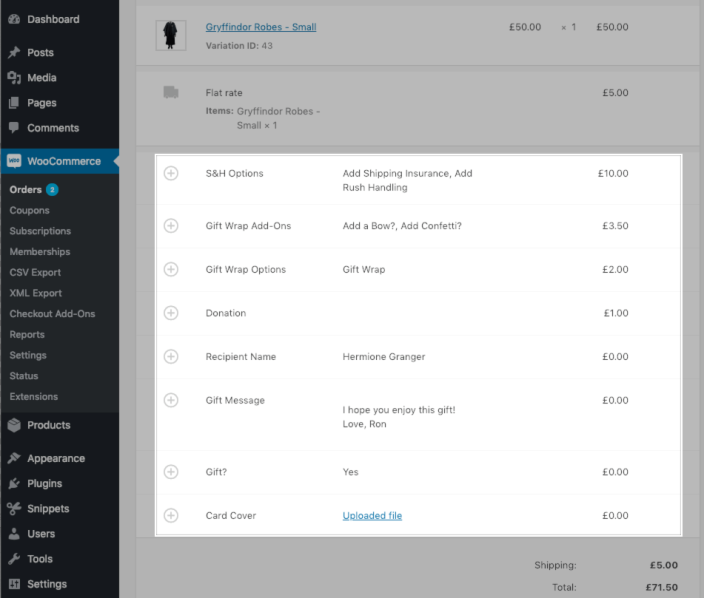
Depending on the selected attributes, administrators can also view add-on fields from the Orders list.

Viewing File Uploads
↑ Back to topThe “File” add-on type lets customers upload a file with their order. When uploaded, files are given a unique suffix to prevent duplicate names. Uploaded files are available in your Media Library and the order itself.
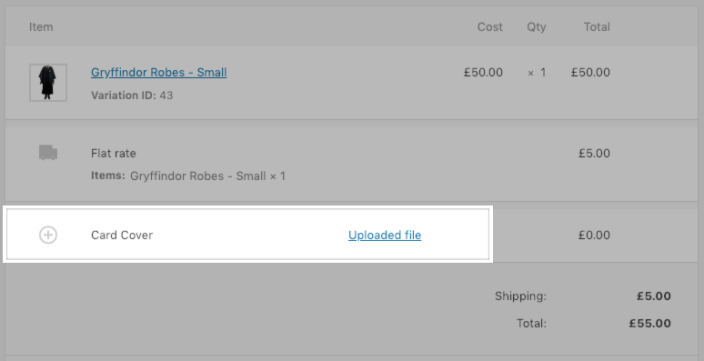
If you have enabled the attribute to display the “File” add-on in the Orders list, you can also access files by selecting the link in the associated column.

Customer View
↑ Back to topClick here to view a sample checkout page with examples of each type of checkout add-on.
The customer can view any selected/populated add-on fields and any associated price adjustments in the order details.
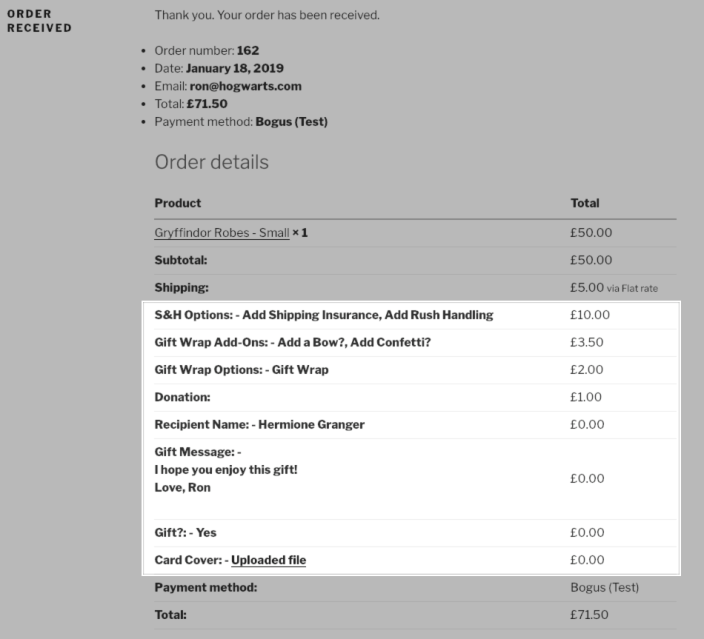
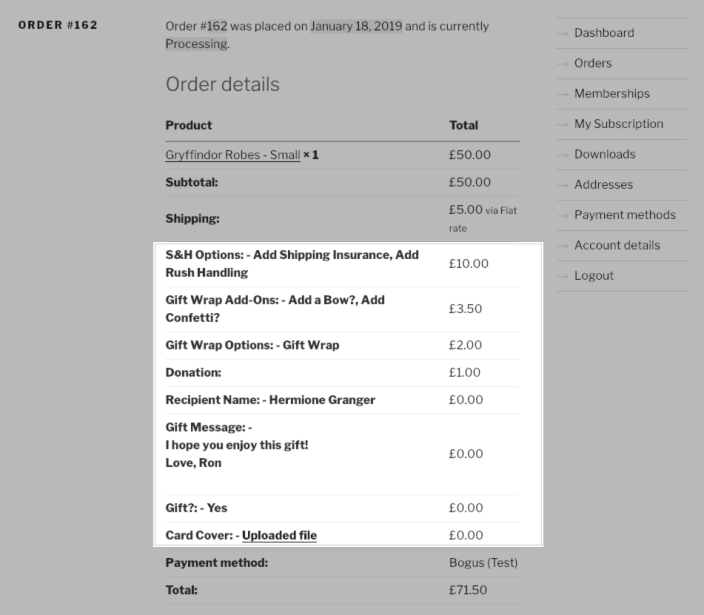
Compatible Plugins
↑ Back to topCheckout Add-ons has dedicated compatibility with Subscriptions and Customer/Order/Coupon Export. As add-ons are WooCommerce order fees, they may appear in exports with other plugins, but Customer/Order/Coupon Export has built-in compatibility.
Customer/Order/Coupon Export – CSV
↑ Back to topCheckout Add-ons is compatible with the WooCommerce Customer/Order/Coupon Export extension. Two new columns will be automatically added to the order export for default or built-in formats, and can be optionally included in custom format exports.
| Column | Description | Outputted Value | Example |
|---|---|---|---|
| checkout_add_on | The value selected for the add-on. “Checkbox” add-on values will display as “Yes” or “No”. | String | FirstName |
| checkout_add_on_total | The associated price adjustment for the add-on. | Numerical | 3.99 |
Checkout Add-Ons in Default or Built-in Exports
When using a default or built-in format, add-ons and any price adjustments are automatically added as columns in the export. To ensure each column name is unique, the add-on’s ID number will be added to the column names for checkout_add_on and checkout_add_on_total.
Checkout Add-Ons in Custom Exports
When using a custom format, you can add your fields as new columns. You’ll need to know the field’s ID, which you can find at the end of the URL when viewing the add-on editor:

You can include add-ons and any associated price adjustments by entering the following in the Data source field:
checkout_add_on_{addonID}: List the add-oncheckout_add_on_total_{addonID}: List the associated discount or fee
You can then add a more descriptive title in the Column name field.
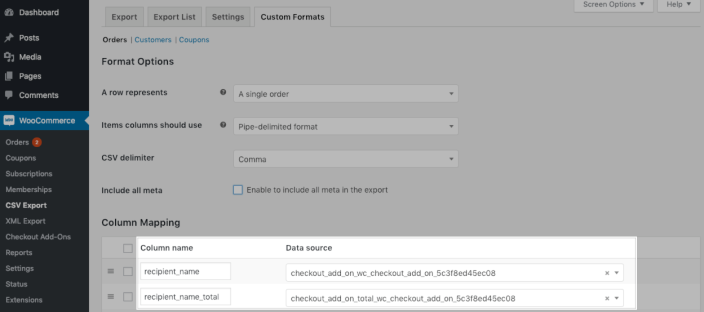
Customer/Order/Coupon Export – XML
↑ Back to topCheckout Add-ons can be used with the XML Export features of the Customer/Order/Coupon Export extension as well. Exported add-on data is automatically added in a dedicated XML tag when using the built-in “Default” or “Legacy” formats. This tag can be optionally included in custom formats.
To include the add-on field value data in a custom XML format, add “CheckOutAddons” to the Data source field. You can include a descriptive title in the Tag name field to replace the standard <CheckoutAddOns> wrapper used for built-in formats.

The add-on name, value, and cost associated with the add-on will be output for each add-on in the element.
An example of the expected XML output:
<CheckoutAddOns>
<CheckoutAddOn>
<ID>field ID</ID>
<Name>field admin name</Name>
<Value>field's customer input for this order</Value>
<Cost>field's total cost added to this order</Cost>
</CheckoutAddOn>
</CheckoutAddOns>
Subscriptions
↑ Back to topIf WooCommerce Subscriptions is active, you can determine which fields should appear in renewal orders. If you use Subscriptions v2.0+, you must use Checkout Add-Ons v1.7.1+.
When creating or editing add-ons, select the “Renew with Subscriptions” attribute to indicate that the add-on should be included in renewal orders.
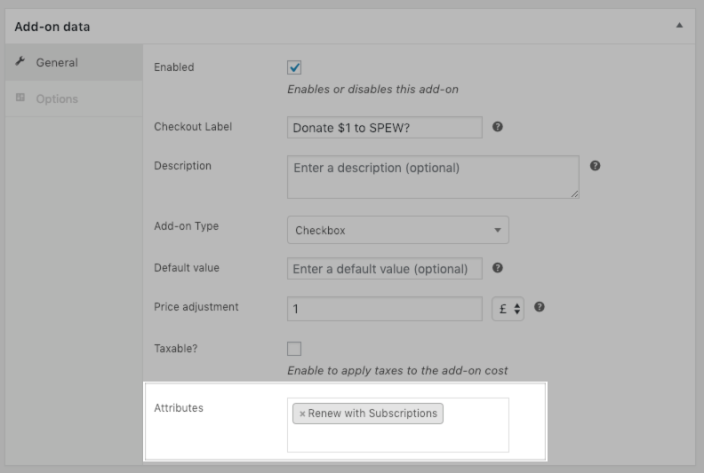
This will include the add-on in the subscription record and any future renewals.
Frequently Asked Questions
↑ Back to top
Q: Are there any character limits for the “Text” or “Text Area” add-on types?
A: No, these types have no character limits. If you need a limit, we recommend suggesting one in the Checkout Label or Description fields. You can also extend the plugin with custom code to set a character limit as described in our developer docs.
Q: Can customers upload multiple files in a “File” add-on?
A: Each “File” add-on permits only one upload. However, you can include multiple fields of this type if necessary. You can also instruct customers to upload ZIP files to include multiple files in one field.
Q: Can I only show add-ons when certain products are purchased?
A: You can use display rules to only show add-ons when a certain product or product category are in the cart, but the add-on will still apply to the entire cart – not to that specific product. If you need add-ons that only apply to certain products, please consider the Product Add-ons extension.
Q: Can I use Checkout Add-Ons with One Page Checkout?
A: Yes! One Page Checkout is supported in Checkout Add-ons from version 1.3.0+.
Q: Can I hide an add-on from the Orders list or do I have to edit its attribute?
A: You can temporarily hide any checkout field shown on the Orders list using the Screen Options tool. Please note that the “Display in View Orders screen” attribute must be enabled for the add-on before it will appear here.

Q: Can I change the way add-ons are displayed on the checkout page?
A: Sure. These fields will inherit the styling set by your theme, so they should match the rest of your inputs already.
If you want to using different styling, you can target #wc_checkout_add_ons with some CSS. For example, let’s say you want to make them only take up 75% of the page in the center, and have some space between them and the customer info. You could add something like this to your child theme or custom CSS stylesheet:
#wc_checkout_add_ons {
width:75%;
margin:30px auto 0px auto;
}
Here’s a tiny bit of CSS we typically use with the Storefront theme to patch radio and checkbox fields:
#wc_checkout_add_ons label.checkbox {
display: inline-block;
margin-left: 5px;
}
Q: Can I use HTML in the add-on field options?
A: You can use HTML in the options for the “Radio” and “Multi-checkbox” add-on types. The HTML should be wrapped in double braces, like so:
{{<a href="link">}}Link Text{{</a>}}
Q: Can I add placeholders or descriptions?
A: Yes, these can be added easily via a code snippet! If you’d like an example, check out our developer docs.
Translating Add-ons
↑ Back to topWooCommerce and most extensions are translation-ready – click here for tips on translating extensions.
This plugin’s text domain is: woocommerce-checkout-add-ons
However, any configurable options (settings for which you enter text, such as the Checkout Label or Description values) are not typically translatable since they’re not strings that the plugin has available in its .pot file. However, some plugins have a way for you to register these options for translation.
WPML Compatibility
↑ Back to topTranslating Labels
You can translate your labels in Checkout Add-ons via WPML so they can be displayed in different languages on your site. First, add this snippet to your site where you keep custom code:
checkout-add-ons.php content:
<?php
function sv_wc_checkout_add_ons_wpml_translate( $label ) {
return apply_filters( 'translate_string', $label, 'woocommerce-checkout-add-ons', $label );
}
add_filter( 'woocommerce_checkout_add_on_get_name', 'sv_wc_checkout_add_ons_wpml_translate' );
add_filter( 'woocommerce_checkout_add_on_get_label', 'sv_wc_checkout_add_ons_wpml_translate' );
function sv_wc_checkout_add_ons_options_wpml_translate( $options ) {
$translated_options = array();
foreach ( $options as $option ) {
$option['label'] = apply_filters( 'translate_string', $option['label'], 'woocommerce-checkout-add-ons', $option['label'] );
$translated_options[] = $option;
}
return $translated_options;
}
add_filter( 'woocommerce_checkout_add_on_get_options', 'sv_wc_checkout_add_ons_options_wpml_translate' );
Then follow these steps to tell WPML to pick up the strings for translation:
- Select one of the “Auto-register” options in WPML > String Translation > Auto register strings for translation.
- The checkout page should have a translation (even just a dummy one) and you should visit one of the non-default language translations for the strings to be picked up.
- No matter where the snippet is placed (theme or plugin), the context in WPML > String Translations will be
woocommerce-checkout-add-ons.
Multi-currency Support
This gist can add WPML multi-currency support to Checkout Add-ons:
wc-checkout-add-ons-wpml-multi-currency.php content:
function wc_checkout_add_ons_wpml_multi_currency_support( $adjustment ) {
return apply_filters( 'wcml_raw_price_amount', $adjustment );
}
add_filter( 'woocommerce_checkout_add_on_get_adjustment', 'wc_checkout_add_ons_wpml_multi_currency_support', 100 );
add_filter( 'wc_checkout_add_ons_add_on_option_cost', 'wc_checkout_add_ons_wpml_multi_currency_support', 100 );
Polylang Compatibility
↑ Back to topYou can register add-on labels and options for translation, and then use them on your checkout. Add this snippet to your site where you keep custom code:
(Be mindful of the opening <?php tag.)
This will let you translate add-on strings under Languages > String Translation.
Troubleshooting
↑ Back to topAre you using the W3 Total Cache plugin? This may cause issues with file uploads. If you use the “minify” feature and plan on using the “File” add-on type, please ensure that you add wp-includes/js/plupload/plupload.full.min.js to the Never minify the following JS files list:

You can read more about this here.
For other issues, please submit a support ticket.
For Developers
↑ Back to topOur Checkout Add-Ons Developer Docs are a resource for developers, with tips on how to add information and attributes, such as placeholders and character limits.
Questions & Support
↑ Back to topHave a question before you buy? Please fill out this pre-sales form.
Already purchased and need some assistance? Get in touch with support via the help desk.
